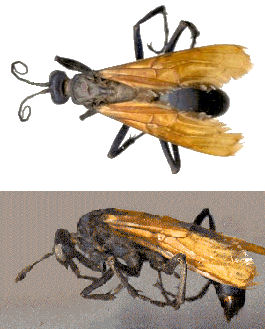 |
TAXONOMY Kingdom Animalia Phylum Arthropoda Superclass Hexapoda Class Insecta Subclass Pterygota Order Hymenoptera Superfamily Vespoidea Family Pompilidae Genus Pepsis Common Name Tarantula Hawks |
 |
TAXONOMY Kingdom Animalia Phylum Arthropoda Superclass Hexapoda Class Insecta Subclass Pterygota Order Hymenoptera Superfamily Vespoidea Family Pompilidae Genus Pepsis Common Name Tarantula Hawks |
Identification
Tarantula Hawks (also known as spider wasps) grow up to 2 inches in length. They have a blue to black robust body which provides elusiveness and protection from their prey, the tarantula. Tarantula Hawk wings range from blue-black to red, orange, or mahogany in color. The coloring of the wings provides warning to potential predators of the Tarantula Hawk. This type of warning coloration is referred to as aposematic coloring. At the end of the wasp's legs they have hooked claws used for attaching themselves to other insects or plants and also for grappling with other insects. Female Tarantula Hawks have a stinger that can be up to 7 mm long and provides one of the most painful stings of any insect.
Natural History
Life Cycle
Adult male Tarantula Hawks will exhibit "hill-topping", in which they will reside on tall plants in search of females ready to copulate. Once impregnated, the female tarantula hawk will lay a single egg on the abdomen of a tarantula. This egg will then develop into a larva, which feeds on the immobile spider. This larva will then mature into its adult form and repeat the process.
Habitat
Tarantula Hawks will reside where tarantulas are found, which is in dry, warm climates such as in the Southwest. They are also found in rainforests. (Tarantula hawks are also most active during the summer, but they seek shelter during extreme heat.)
Behavior
Typical behavior of the tarantula hawk is non-aggressive. They are nectar-feeding insects that only exhibit aggression when the females need to immobilize a tarantula to lay her eggs. The female tarantula hawks will seek out either wandering tarantulas or invade burrows. The wasp provokes the tarantula into raising its body so that the wasp can sting the tarantula's abdomen, immediately causing paralysis to the tarantula. Another means of attack is to try to flip over the tarantula by grabbing its leg and then stinging its abdomen. It will then drag the body to its nesting burrow. One egg is laid on the abdomen of the spider. Once a larva, it will eat the tissues of the spider, while avoiding organs so as to preserve freshness. Typically these spider wasps are most active during the day, avoiding high temperatures.
Distribution
Tarantula Hawks have been found throughout southern North America south to Argentina. In North America, these wasps are found mainly populating the desert regions. Over this range, at least 250 different species are recorded
References
Burnie, D. 2000. The KingFisher Illustrated Animal Encyclopedia. Retrieved 2 November 2007 from http://www.houghtonmifflinbooks.com
Garmon, B., and F. Punzo. 1989. Effects of encounter experience on the hunting behavior of the spider wasp, Pepsis formosa (Hymenoptera: Pompilidae). The Southwestern Naturalist, 34(4): 513-518.
Williams, B. D. 1996-2007. Tarantula Hawks. Retrieved 2 November 2007 from http://www.desertusa.com/mag01/sep/papr/thawk.html.
This webpage was created by Noami Marquez, Erik Balderrama, and Jessica Westin in partial fulfillment of Entomology, 2007, University of Texas at El Paso. The views in this webpage are based on our research and may not reflect the views of the University of Texas system.